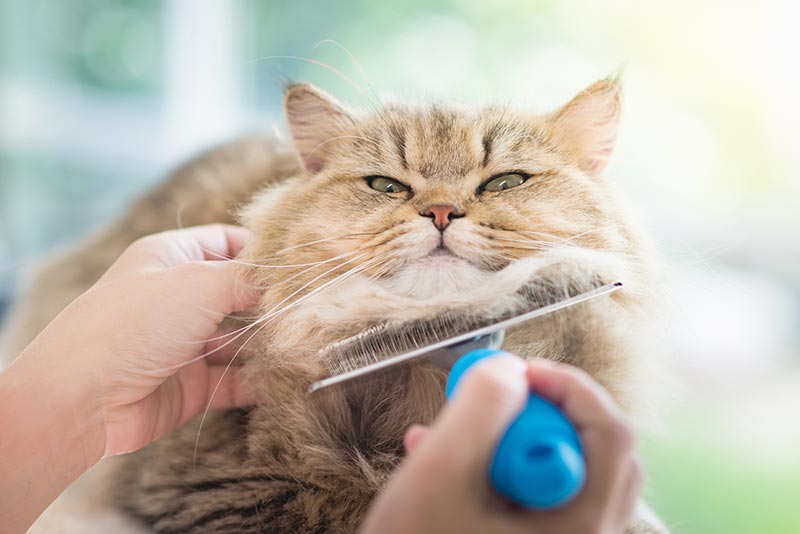
Hey there, fellow cat enthusiasts! If you’ve ever found yourself marvelling at a beautifully groomed feline wondering, “How do they do it?” – we’ve got you covered. Cats are notorious for their meticulous self-grooming habits, but they can still benefit from a helping hand. Whether you’re a new cat owner or a seasoned pro looking to up your grooming game, this guide will equip you with the knowledge and skills to transform your furry friend into the most dapper kitty on the block.
So, roll up your sleeves, grab your grooming tools, and let’s embark on this feline beautification journey together!
The Kitty’s Dilemma: Why grooming is crucial for your cat’s well-being?
Did you know that regular grooming not only keeps your cat looking dashing but also plays a vital role in their overall health and happiness? By lending a helping hand to your feline friend’s grooming routine, you can prevent a variety of issues such as hairballs, matting, and skin irritations. Plus, it’s an excellent opportunity for bonding and creating a deeper connection with your furry companion.
To Brush or Not to Brush: Debunking the myth of self-sufficient grooming
While cats are natural-born groomers, their tongues can only do so much. Long-haired breeds in particular are prone to matting and hairballs, making regular brushing an essential part of their care routine. Even short-haired kitties can benefit from a gentle brush to remove loose fur and distribute natural oils for a healthier coat.
Most cats do wash themselves constantly and this is one of the reasons why grooming is so beneficial. When cats wash themselves by licking, they deposit saliva all over their fur which eventually does need to be washed off!
Washing, along with brushing and combing, also helps to get rid of loose hairs so the cat ingests fewer when licking.
Old or poorly cats often do not wash themselves so a helping hand is always appreciated.
1. The Right Brush for the Job: Choose the best brush for your cat’s coat type
Before diving into the brushing process, it’s essential to select the right brush for your feline’s fur type. Different brushes cater to specific needs, such as removing tangles, reducing shedding, or adding shine. For long-haired cats, a slicker brush or a comb with long teeth can work wonders.
Short-haired cats, typically respond well to a rubber brush to loosen dead hair and any dirt or debris. Following with a fine toothed cat comb to remove any remaining dead hair is also beneficial and satisfying for them!
Hairless cats, on the other hand, have very specific grooming needs. Because they produce so much excess oil, they need to be bathed once a week or they will develop blackheads and skin infections and will also leave oily patches wherever they rest! To avoid this, you will need to pick a mild shampoo that does not have a scent. Most sphynx experts recommend using a shampoo designed specifically for cats, such as our WildWash Cat Shampoo.
For this process, you will need to use a soft scrunchie or brush to gentle exfoliate the skin to keep pores free of sebum build up and help prevent blackheads.
Dive deeper into the grooming process of each feline breed, as we provide detailed explanations and valuable insights in our Coat Care Guide for Cats.
2. Nail the Nail Trimming: Tips and tricks for a stress-free manicure.
Trimming your cat’s nails may sound like an intimidating task, but with the right approach, it can become a breeze. Start by gently introducing your furry friend to the clippers and gradually get them comfortable with the process. Be sure to use cat-specific nail clippers, avoid cutting too close to the quick, and have some treats on hand to reward your cat’s cooperation. Some people find the Guillotine Nail Clipper easier to use than the conventional clipper.
3. Tackling Tangles: Tips for dealing with mats and knots.
Mats and tangles can turn your cat’s luxurious coat into a messy nightmare. To remove them without causing discomfort, apply a detangling spray to the affected area. Gently work through the mats using your fingers or a comb, starting from the edges and gradually making your way towards the base of the fur.
Our WildWash Pro Silicone Free Detangle for Cats uses Camellia Japonica which has super emollient and detangling qualities It smoothes cuticles and increases elasticity, allowing easy separation of the matted hair. It also contains nutrients to help reconstruct damaged hair tissue. Lemon Myrtle Leaf Oil and Rose Water help nourish and condition whilst imparting a subtle and delicate fragrance.
4. Eye on the Eyes: Keeping those peepers clean and clear.
Cats’ adorable eyes are not immune to dirt and discharge build up. Here, grooming is a must! To prevent potential infections gently wipe the corners of your cat’s eyes using a soft, damp cloth or a specialised eye cleanser. If you notice any persistent issues or changes in your cat’s eye appearance, consult your veterinarian.
• How often should I groom my cat?
The frequency of grooming sessions depends on your cat’s coat type. Long-haired cats typically require daily grooming to prevent matting, while short-haired cats can benefit from weekly brushing sessions. Regular nail trims and ear cleanings should be done as needed.
• Can I use human grooming products on my cat?
In short, the answer is NO. It’s essential to use cat-specific grooming products as human products can contain ingredients that are harmful to felines. Consult your veterinarian or a professional groomer for recommendations on safe and suitable grooming products.
• Are there any specific grooming considerations for senior cats?
Senior cats may require some additional grooming care due to age-related changes in their fur and skin. They may have difficulty reaching certain areas for self-grooming, resulting in more frequent matting or dirty fur. Regular brushing and gentle grooming can help keep their coat clean and free from tangles. Additionally, senior cats may develop arthritis or other mobility issues, so providing a comfortable and accessible grooming area is important. Monitor their skin for any signs of dryness, irritation, or lumps, and consult with your veterinarian if you notice any concerning changes.
• Can I groom my cat if they have sensitive skin?
If your cat has sensitive skin, it’s important to approach grooming with extra care. Choose grooming products that are specifically formulated for cats with sensitive skin, as they are designed to be gentle and less likely to cause irritation. Test any new products on a small area of your cat’s skin before applying them more extensively to ensure they don’t have an adverse reaction. Additionally, opt for softer brushes or combs that won’t scratch or irritate the skin. If you notice any signs of discomfort or skin issues during grooming, consult with your veterinarian for further guidance.
• How do I handle my cat’s ears during grooming?
Answer: Grooming your cat’s ears is an essential part of their overall care routine. However, it requires special attention and a delicate touch. Start by getting your cat comfortable with having their ears touched by gently stroking them during cuddle sessions. When it’s time for ear cleaning, use a cat-specific ear cleaning solution and a soft cotton ball or pad. Never insert anything deep into your cat’s ear canal, as this can cause injury. Instead, focus on gently wiping the visible parts of the ear. If you notice any redness, swelling, or discharge, consult with your veterinarian, as these could be signs of an underlying ear issue.
• Should I groom my indoor cat differently from an outdoor cat?
Indoor and outdoor cats have different grooming needs. Outdoor cats may require more frequent grooming due to exposure to dirt, debris, and potential parasites. They may also benefit from regular flea and tick prevention treatments. Indoor cats generally have less exposure to external elements, but they still need regular grooming to maintain a healthy coat and prevent matting. Additionally, indoor cats may benefit from nail trims more frequently since they have fewer opportunities to wear down their claws naturally. Adjust the grooming routine based on your cat’s lifestyle and individual needs.
Share this post with your friends and family
Follow Us for updates, info and tips
Developed by GW 'The Marketing Guy' | All Rights Reserved | © 2024 WildWash

Join our email list to stay up-to-date about the latest products and offers, plus get
10% OFF
your first purchase.
By submitting, you agree to receive marketing emails for information on news, promotions, and offers from WildWash. For more details see our Terms & Conditions and Privacy Policy. You can unsubscribe at anytime.
